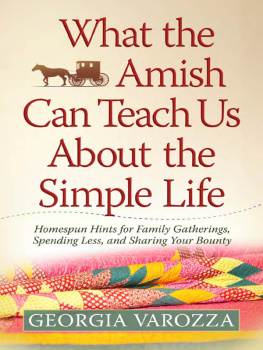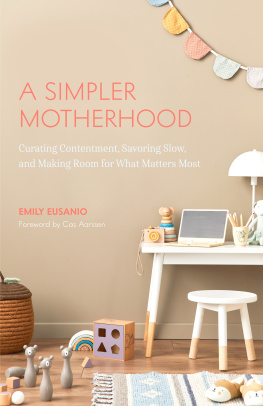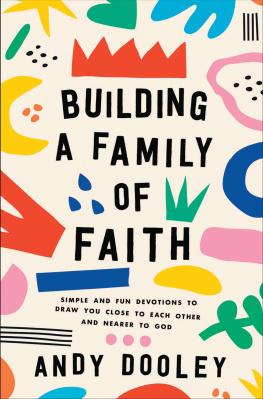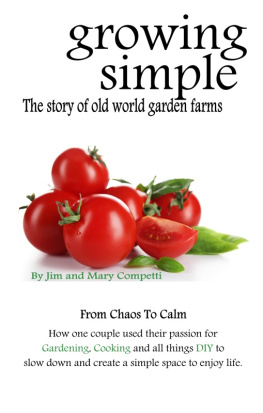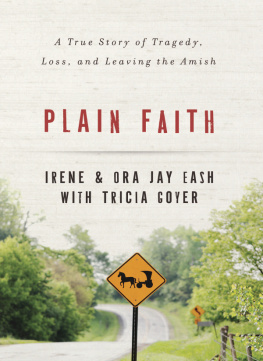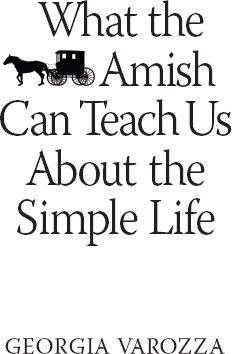

HARVEST HOUSE PUBLISHERS
EUGENE, OREGON
Unless otherwise indicated, Scripture quotations are taken from the Holy Bible, New International Version, NIV. Copyright 1973, 1978, 1984, 2011, by Biblica, Inc. Used by permission of Zondervan. All rights reserved worldwide. www.zondervan.com
Verses marked NASB are taken from the New American Standard Bible, 1960, 1962, 1963, 1968, 1971, 1972, 1973, 1975, 1977, 1995 by The Lockman Foundation. Used by permission. (www.Lockman.org)
Cover design by Garborg Design Works, Minneapolis, Minnesota
Cover photos Chris Garborg; Bigstock
Neither the author nor the publisher assumes any liability for possible adverse consequences as a result of the information contained herein.
WHAT THE AMISH CAN TEACH US ABOUT THE SIMPLE LIFE
Copyright 2013 by Georgia Varozza
Published by Harvest House Publishers
Eugene, Oregon 97402
www.HarvestHousePublishers.com
Library of Congress Cataloging-in-Publication Data
Varozza, Georgia.
What the Amish can teach us about the simple life / Georgia Varozza.
p. cm.
ISBN 978-0-7369-5260-6 (pbk.)
ISBN 978-0-73-69-5261-3 (eBook)
1. Conduct of life. 2. AmishConduct of life. 3. MennonitesConduct of life. I. Title.
BJ1581.2.V37 2013
248.4'8973dc23
2012030034
All rights reserved. No part of this publication may be reproduced, stored in a retrieval system, or transmitted in any form or by any meanselectronic, mechanical, digital, photocopy, recording, or any otherexcept for brief quotations in printed reviews, without the prior permission of the publisher.
To my family.
You cheerfully put up with my many experiments
and (almost!) never complained.
May the Lord bless you and keep you,
and may you walk with Him always.
I love you all.
To Paula.
In our happy quest to care for our families,
weve tried just about everything.
We are definitely two peas in a pod!
And to Nick Harrison.
You gave me the encouragement I needed to
enlarge the place of my tent (Isaiah 54:2).
I am blessed to know you.
Contents
I have a vivid recollection of my plain aunties (great aunts, really) coming to visit when I was a young child. They were solid farm women with prayer caps on their heads and demurely patterned dresses. They treated me kindly and laughed a lot with my mother. They helped me embroider my first projecta pillowcase that had a design of two squirrels running up a branch. I picked out the pattern all by myself (I must have been about seven at the time), and I thought it was lovely.
I have another memory from this time, but it isnt nearly as positive. A boy from my school (I was in second grade) teased me during recess about those stupid Amish, only he mispronounced it Ay-mish. The only defense I knew was to tell him he was saying Amish wrong and he didnt know anything.
I grew up learning about the Amish and other plain Anabaptists decades before some of the communities became tourist attractions. I admired their industriousness and simple lifestyles. Even as a youngster I wanted to emulate those qualities. In fact, I remember being teased for years about being born a hundred years too late. I didnt mind the teasing at all because I quite agreed.
To help make ends meet when I went away to college, I made quilts, embroidered shirts, and crocheted afghans that I sold to my fellow students. For a time I lived in a third-floor walk-up in San Francisco. Though I was surrounded by a citys worth of concrete and high-rises, I still managed to gardenon the fire escape. Id climb out my kitchen window and grab a handful of herbs or a bit of lettuce or spinach for a meal, never once stopping to think this might seem odd to other city dwellers.
When I was preparing to get married, my gift list gave my poor mother fits. I didnt have a china pattern or list of linens and fancy gadgets our guests could use as a guide. No, my list consisted of such things as a pressure canner, canning jars (as many as anyone cared to buy!), a wheelbarrow, a tiller, and a garden spade, just to name a few. And when my husband and I shopped for our first home, I didnt really care what the house looked like. It was the dirt that surrounded the house that grabbed my attention. After all, a house could be fixed, but the land is forever.
When our children were young, we attended a conservative AmishMennonite church in the area. I dressed plain (made from a homemade pattern supplied by one of my church sisters) and wore a head covering. In their quiet way, the women of the church accepted me, and I developed happy friendships with a number of them. Together we harvested and canned produce from our gardens and shared recipes and housekeeping tips. We ate together and visited while the children played outside. I fondly recall a tradition several of the families had. After eating, while the adults were yet seated and visiting, the children would stand behind us and gently massage our necks. What a lovely way to end a meal! This gave the grown-ups a chance for one last cup of coffee or sun tea before we women popped up to do the dishes and the men wandered off to discuss whatever was of current interest.
Church services were a hushed and holy affair. We would silently enter the sanctuary; women seated on the left, and men seated on the right. Hymns were sung a cappella, and at the beginning of each verse the songster would lead in. The congregation always paused before beginning to sing along. Everyone knew the hymn by heart, but that show of humility was the way things were done. The minister delivered his sermon with a quiet earnestness that spoke to my heart, and praying was done on our knees, heads bowed, our faces covered by our hands.
There were also work frolics , when the women would gather in the basement of the church to piece and tie comforters for those less fortunate. In the summer there was Bible school for the children, and in October, revival meetings took place every evening for an entire week. Visiting ministers would speak, and the faithful were exhorted to honor Christ in all things and to live lives reflective of the Saviors redeeming work.
In many ways, those were halcyon days for our family. We spent our time close to home, busy with the work of living. We eschewed television, radio, and electronic games and gadgets. If we wanted to have fun, we made it ourselves. My children were full of creative ideas for play, and they spent many hours outside just being kids.
My twin sister, Paula, and her children lived nearby. We joined forces often as our days unfolded. Our kids were very close, and cousin squabbles were thankfully few and far between. Paula and I had plenty of time to work together on the tasks of the day and season. Processing and canning 40 quarts of tomato sauce in one day? Not a problem. Picking and freezing gallons and gallons of blueberries from my 53 blueberry bushes? Enjoyable. My sister and I worked together, and we truly experienced the adage that many hands make light work.
Both of us had an insatiable curiosity coupled with a strong desire to care for our families. We attempted many projects together over the years. Some were unmitigated disasters, like the time we decided we would only scythe the grain we grew. That didnt last long because we quickly discovered it was extremely hard work, took a lot of time, and required much skill. But other projects were grand successes so weve incorporated them into our routines.
Next page
